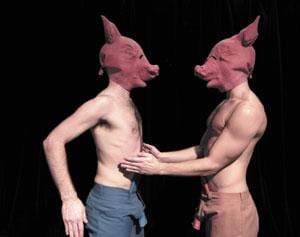Two guys roll naked on the floor, save for tiny bikini briefs and pig masks. Liberace is played. Cupcakes are consumed. Pineapples are destroyed.
Welcome to Liklik Pik, the sexually charged, unabashedly queer waltz through the world of all things pig, conceived by Montreal-based choreo-grapher George Stamos.
“In the gay world, the word pig connotes a kind of uninhibited sexuality that includes things like fisting, piss and cum swapping,” says Stamos. “It’s a uniquely gay identity because gay men are more free to embrace their masculinity in a sexual sense. In the straight world, when men are referred to as pigs, it’s usually in the male chauvinist sense. This often leads them to downplay their animal side for fear of seeming sexist or too macho.”
Though the sexual overtones are obvious, Stamos is quick to point out that the piece is about much more.
“We have this cultural dichotomy of the pig as a filthy animal rolling in its own shit, and at the same time as a sensitive, intelligent creature, like the film Babe or the book Charlotte’s Web,” he says. “I’m interested in highlighting that double meaning and exploring how it relates not just to the sexual excess of the gay world, but all our other societal constructs around this animal.”
These kinds of cultural intersection points are a primary interest for Stamos. (His last work, Cloak, evoked the bunny as both cute furry animal and hyper-sexualized female form.) His creations typically possess neither cohesive narrative nor specific message. Rather, they serve to stimulate discussion without being afraid to entertain.
“A lot of contemporary work is very antiestablishment and seems content to bore or annoy people,” he says. “I’m quite happy to have people escape from their daily life for a few hours and hopefully leave thinking a little differently about the world and themselves.”
Though he’s maintained a career spanning more than two decades (an accomplishment in an industry best known for degenerative injuries and empty bank accounts), it was an accident that Stamos became a dancer at all. After leaving behind a messy home life in rural Nova Scotia at 15, he was caught shoplifting a carton of cigarettes while living on the streets of Halifax. Sentenced to a month of community service, he found himself cleaning a dance studio, which inspired him to start drop-in classes.
He hitchhiked from Halifax to Toronto at 18, intent on studying at the School of Toronto Dance Theatre, but quickly realized the program wasn’t for him. Instead, he found his creative education in the local club scene, playing with obscure feminist punk bands and go-go dancing in gay clubs.
“Professional dance programs are often intent on sapping the individuality out of students, turning them into performance machines,” he says. “That didn’t appeal to me because of the scene I was involved with. I learned more dancing in nightclubs than I did in classes. As an artist and as an audience member, I’m much more interested in what’s unique about performers, rather than how well they fit into a mould.”
Stamos also immersed himself in activist culture, working with AIDS and sex-worker rights groups as well as countering pro-life actions outside the Morgentaler Clinic. In 1990 he left Toronto for London, where he squatted with anarchists in the gritty East End and partied with the likes of Boy George and Leigh Bowery. He went on to study at the School for New Dance Development in Amsterdam, and after a brief stint in New York, found himself in Montreal, where he’s now made his home.
“Being part of the activist community has had a huge impact on how I want to work,” Stamos says. “I like non-hierarchical structures, and I want to work with people who bring their own opinions to the table rather than just doing as they’re told. Dancing can be painful and exhausting, so if my collaborators feel like I don’t care about them, they’re less likely to bring their ideas to the process or be willing to do the kinds of crazy things I want them to do.”
Below is a video preview of the show and an interview with George Stamos.


 Why you can trust Xtra
Why you can trust Xtra


